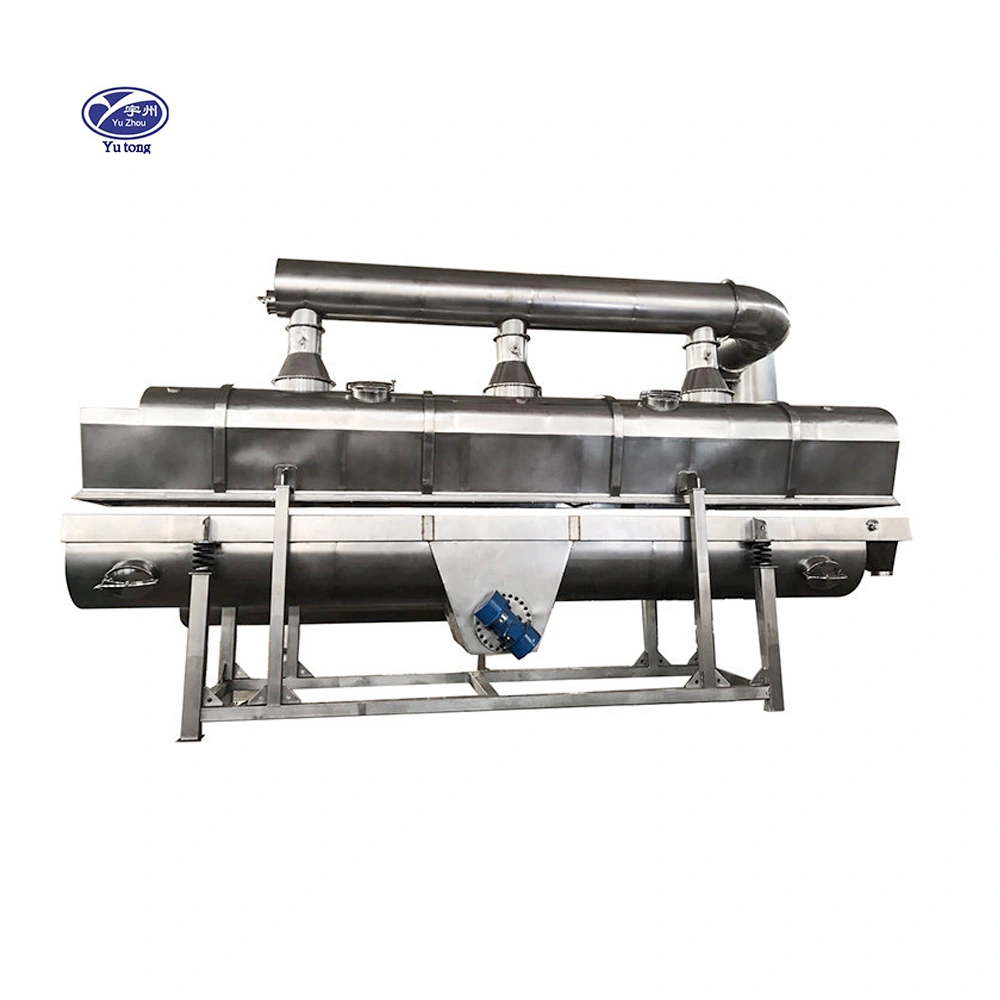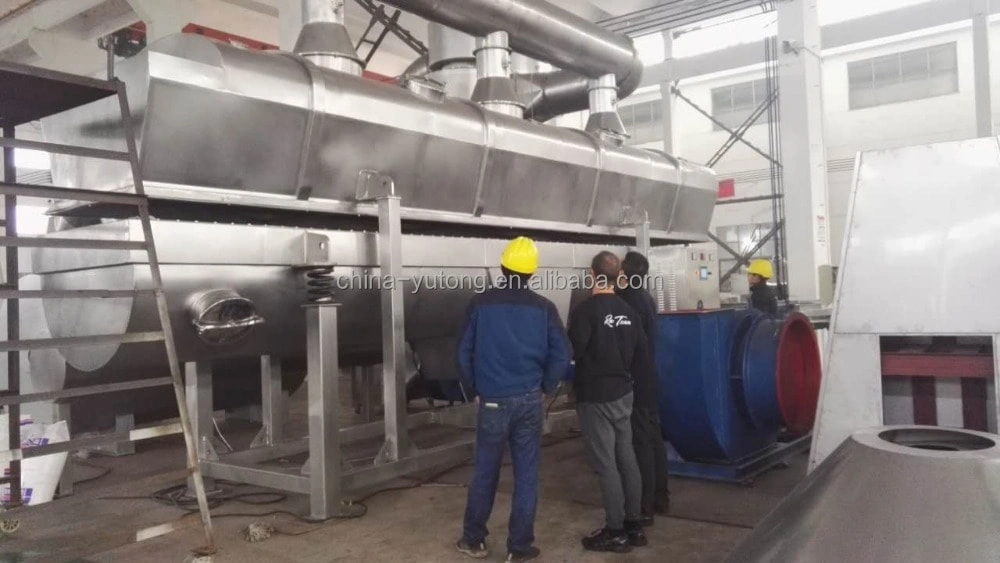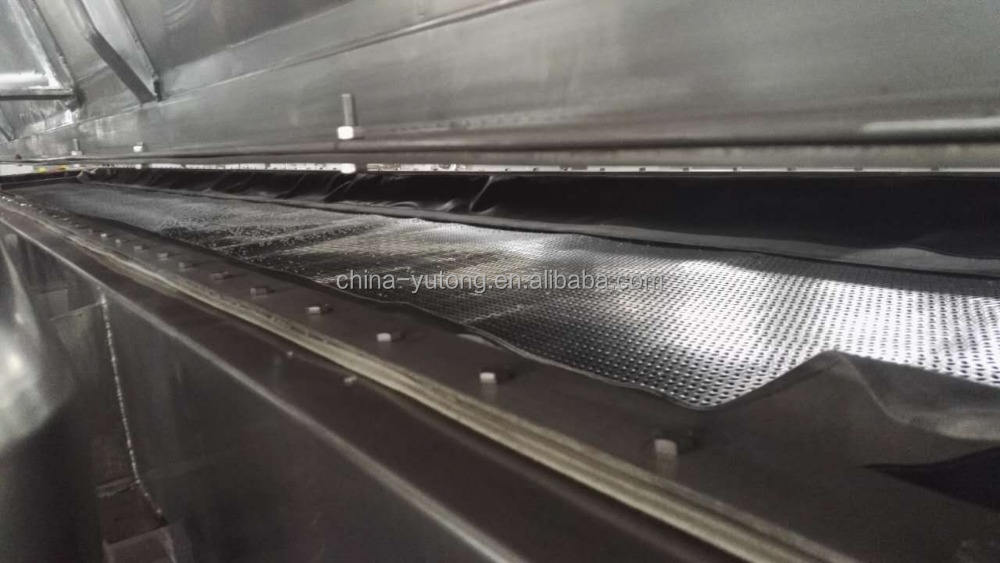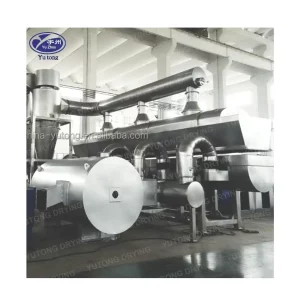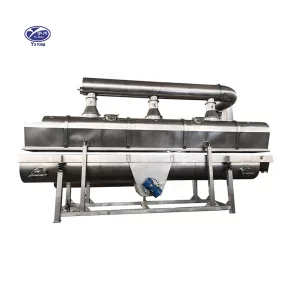Table of Contents
Product Detail
bed dryer fluidized
A fluidized bed dryer is a type of equipment that uses the principle of fluidization to dry granular materials efficiently. In this process, hot air is passed through a bed of solid particles at high velocity, causing the particles to become suspended and behave like fluids. This fluidization enhances the contact between the hot air and the material, resulting in faster and more uniform drying.
The Fluidization Process
The fluidization process involves transforming solid particles into a fluid-like state. This is achieved by introducing air at a velocity that is enough to suspend the particles, facilitating free movement. This state improves heat and mass exchange between the air and the particles, making the drying process more efficient. Adjusting the velocity of the air can control the degree of fluidization, allowing for precise drying conditions.
Particle Suspension Dynamics
Particle suspension in a fluidized bed dryer is crucial for achieving uniform drying. The turbulence created by the airflow ensures that each particle is evenly exposed to the hot air, preventing hotspots and uneven moisture removal. This not only speeds up the drying process but also enhances the consistency and quality of the end product. Understanding the dynamics of particle suspension helps in optimizing dryer settings for different materials.
Material Adaptability
Fluidized bed dryers are highly adaptable to a wide range of materials. Whether dealing with fine powders or larger granules, these dryers can be adjusted to accommodate different particle sizes and densities. This flexibility makes them suitable for diverse industrial applications, from pharmaceuticals to food processing. The ability to handle various materials efficiently is one of the key reasons fluidized bed dryers are so widely used.
Working Principle of Fluidized Bed Dryer
The working principle of a fluidized bed dryer involves the suspension of solid particles in a stream of hot air. The air velocity is adjusted to lift the particles, creating a fluid-like state. This state allows for efficient heat and mass transfer, leading to rapid moisture removal from the particles. The process continues until the desired moisture content is achieved.
Heat and Mass Transfer
Adequate heat and mass transfer are the core of the fluidized bed drying process. As particles are suspended, they are surrounded by hot air on all sides, which allows for quick and uniform heat distribution. This efficient transfer of heat reduces the time required to achieve the desired moisture content, enhancing the overall drying process. Mass transfer is equally important, as it involves the removal of moisture from the particle surfaces into the air stream.
Air Flow Control
Controlling the airflow is essential for maintaining the fluidized state and optimizing the drying process. By adjusting the air velocity, operators can ensure that particles remain suspended and that heat and mass transfer are maximized. Proper airflow control also prevents particle agglomeration and ensures even drying. Advanced fluidized bed dryers are equipped with sophisticated systems to regulate air flow for precise, optimal performance.
Moisture Content Monitoring
Monitoring the moisture content is critical in the fluidized bed drying process. Accurate sensors and control systems continuously measure the particles’ moisture levels. This data is essential for adjusting the drying parameters in real-time to achieve the desired final product quality. Effective moisture monitoring ensures that the drying process is both efficient and consistent, minimizing energy consumption and maximizing output.
Advantages of Fluidized Bed Dryer
Fluidized bed dryers offer several advantages over traditional drying methods:
Uniform Drying
The fluidization process ensures that all particles are exposed to the hot air uniformly, resulting in consistent drying. This uniformity is crucial for maintaining product quality and ensuring that the final product meets the required specifications. By preventing uneven drying, fluidized bed dryers help reduce defects and improve the overall reliability of industrial processes.
Faster Drying Rates
Due to the enhanced heat and mass transfer, fluidized bed dryers achieve faster drying times compared to other methods. This increased speed not only boosts productivity but also reduces operational costs. Faster drying rates allow for higher throughput, making these dryers an attractive option for industries looking to scale up production without compromising quality.
Energy Efficiency
The efficient transfer of heat minimizes energy consumption, making fluidized bed dryers a cost-effective option. By optimizing the use of energy, these dryers reduce the overall environmental impact of the drying process. Energy efficiency is a key consideration for industries aiming to achieve sustainability goals and reduce operational expenses.
Versatility
These dryers can handle a wide range of materials, from fine powders to coarse granules, making them suitable for various industries. Fluidized bed dryers’ adaptability means they can be used in different applications without the need for significant modifications. This versatility translates to reduced equipment investment and operational costs for companies operating in multiple sectors.
Scalability
Fluidized bed dryers are available in different sizes and configurations, allowing for easy scalability based on production needs. Whether for small-scale operations or large industrial plants, these dryers can be scaled up or down to match specific production requirements. Scalability ensures that companies can efficiently expand their operations as demand increases without the need for entirely new equipment investments.
Uses of Fluidized Bed Dryer
Fluidized bed dryers find applications in numerous industries due to their versatility and efficiency. Some common uses include:
Pharmaceutical Industry
In the pharmaceutical industry, fluidized bed dryers are used for drying granules and powders. They ensure uniform drying, which is crucial for maintaining the quality and efficacy of pharmaceutical products.
Ensuring Product Efficacy
The uniform drying capabilities of fluidized bed dryers are essential for maintaining the stability of active ingredients in pharmaceutical formulations. By providing consistent moisture removal, these dryers help ensure that the final product retains its intended therapeutic effects. This reliability is critical for meeting stringent regulatory standards and ensuring patient safety.
Process Optimization
Fluidized bed dryers contribute to process optimization in pharmaceutical manufacturing. Their ability to handle various drug formulations and drying requirements streamlines production processes, reducing downtime and enhancing efficiency. By optimizing drying operations, pharmaceutical companies can achieve higher yields and lower production costs.
Compliance with Regulatory Standards
Adhering to regulatory standards is a top priority in the pharmaceutical industry. Fluidized bed dryers offer precise control over drying parameters, enabling manufacturers to comply with Good Manufacturing Practices (GMP) and other regulatory requirements. This compliance ensures that pharmaceutical products are safe, effective, and of the highest quality.
Food Industry
Fluidized bed dryers are employed in the food industry to dry food grains, cereals, and other edible products. The gentle drying process helps preserve the nutritional value and flavor of food.
Nutritional Preservation
One of the primary benefits of using fluidized bed dryers in the food industry is preserving nutritional content. By maintaining moderate drying temperatures and uniform airflow, these dryers help retain vitamins, minerals, and other essential nutrients. This is crucial for producing healthy and nutritious food products that meet consumer demands.
Flavor Retention
In addition to preserving nutrients, fluidized bed dryers also help retain food products’ natural flavors. The gentle drying process minimizes the loss of volatile flavor compounds, ensuring that the final product is both tasty and aromatic. This makes fluidized bed dryers an ideal choice for food manufacturers seeking to deliver high-quality, flavorful products to the market.
Consistency and Quality
Consistency in drying is vital for maintaining the quality of food products. Fluidized bed dryers provide uniform drying conditions, resulting in products with consistent texture, appearance, and quality. This consistency is essential for building consumer trust and maintaining a brand reputation in a competitive food market.
Chemical Industry
In the chemical industry, fluidized bed dryers are used to dry chemicals, catalysts, and other granular materials. The uniform drying helps achieve the desired chemical properties and quality.
Catalyst Preparation
Fluidized bed dryers play a crucial role in preparing catalysts for chemical reactions. By ensuring uniform drying, these dryers help achieve the precise physical and chemical properties required for effective catalysis. This uniformity enhances the performance and efficiency of chemical processes.
Quality Control
Quality control is paramount in the chemical industry, where slight deviations can lead to significant consequences. Fluidized bed dryers offer precise control over drying parameters, ensuring consistent product quality. This control helps chemical manufacturers meet stringent quality standards and deliver reliable products to their customers.
Process Efficiency
Efficiency is a key consideration in chemical manufacturing. Fluidized bed dryers contribute to process efficiency by reducing drying times and energy consumption. This efficiency translates to lower operational costs and increased competitiveness in the chemical industry.
Other Industries
Fluidized bed dryers are also used efficiently to dry various materials in industries such as agriculture, mineral processing, and waste management.
Agricultural Applications
In agriculture, fluidized bed dryers are used for drying seeds, grains, and other agricultural products. The efficient drying process helps preserve the quality and viability of seeds, ensuring successful planting and high crop yields. This application is vital for supporting food security and agricultural sustainability.
Mineral Processing
The mineral processing industry benefits from the use of fluidized bed dryers for drying mined ores and minerals. By providing consistent and uniform drying, these dryers enhance the quality and value of mineral products. This is essential for maximizing the profitability of mining operations and meeting market demands.
Waste Management
Fluidized bed dryers are increasingly used in waste management to dry sludge and other waste materials. The efficient drying process reduces the volume and weight of waste, facilitating more straightforward disposal and recycling. This application supports environmental sustainability and waste reduction efforts.
Types of Fluidized Bed Dryers
There are several types of fluidized bed dryers, each designed to suit specific applications and materials:
Vibrating Fluidized Bed Dryer
Vibrating fluidized bed dryers incorporate mechanical vibration to enhance fluidization and improve drying efficiency. This type is ideal for materials that are difficult to fluidize or tend to stick together.
Enhanced Fluidization
The addition of mechanical vibrations helps overcome challenges associated with fluidizing complex materials. By breaking up particle agglomerations, vibrating fluidized bed dryers ensure more effective fluidization and drying. This enhancement is particularly beneficial for sticky or cohesive materials that resist conventional fluidization.
Improved Drying Rates
Vibrating fluidized bed dryers offer improved drying rates by facilitating better heat and mass transfer. The vibrations create additional turbulence, enhancing the interaction between hot air and particles. This leads to faster moisture removal and reduced drying times, increasing overall process efficiency.
Versatile Applications
The versatility of vibrating fluidized bed dryers makes them suitable for a wide range of applications. From drying polymers and resins to food products and pharmaceuticals, these dryers can handle diverse materials with ease. Their adaptability is a key advantage for industries dealing with varying product requirements.
Steam Fluidized Bed Dryer
Steam fluidized bed dryers use steam as the heat source instead of hot air. This approach is beneficial for heat-sensitive materials or when a high degree of control over the drying environment is required.
Gentle Drying for Sensitive Materials
Steam-fluidized bed dryers provide a gentle drying environment that is ideal for heat-sensitive materials. By using steam, these dryers maintain lower drying temperatures, reducing the risk of thermal degradation. This gentleness is crucial for preserving the integrity and quality of delicate products.
Precision Control
The use of steam as a heat source allows for precise control over drying parameters. Operators can adjust steam pressure and temperature to achieve optimal drying conditions for specific materials. This precision is essential for ensuring consistent product quality and meeting stringent industry standards.
Energy Efficiency
Steam-fluidized bed dryers are also known for their energy efficiency. By utilizing steam, these dryers can achieve effective drying with lower energy consumption compared to traditional methods. This efficiency is beneficial for industries looking to reduce operational costs and minimize environmental impact.
Continuous Fluidized Bed Dryer
Continuous fluidized bed dryers are designed for large-scale production. Materials are continuously fed into the dryer and discharged upon reaching the desired moisture content. This type is widely used in industrial processes that require high throughput.
High Throughput Capabilities
Continuous fluidized bed dryers are ideal for processes that demand high throughput and consistent production rates. By continuously feeding and discharging materials, these dryers ensure uninterrupted operation and maximize productivity. This capability is essential for industries with high production demands.
Consistent Product Quality
The continuous operation of these dryers ensures consistent drying conditions, resulting in uniform product quality. This consistency is crucial for maintaining product standards and meeting customer expectations. Continuous fluidized bed dryers are particularly advantageous for large-scale manufacturing where quality consistency is paramount.
Cost-Effective Operation
Continuous fluidized bed dryers offer cost-effective operation by reducing downtime and labor requirements. Their automated and constant process minimizes the need for manual intervention, lowering operational costs. This efficiency makes them a preferred choice for industries seeking to optimize production and reduce expenses.
Design and Construction of Fluidized Bed Dryer
The design and construction of a fluidized bed dryer are critical to its performance and efficiency. Key components include:
- Air Distributor: Ensures uniform distribution of air across the bed.
- Drying Chamber: The main area where fluidization and drying occur.
- Heating System: Provides the necessary heat for drying, which can be supplied by gas, electricity, or steam.
- Exhaust System: Removes moisture-laden air from the dryer.
Air Distribution Systems
Effective air distribution is vital for achieving uniform fluidization and drying. The air distributor plays a crucial role in ensuring that air is evenly distributed across the bed, preventing dead zones and uneven drying. Advanced designs incorporate adjustable air distributors to accommodate different materials and optimize drying efficiency.
Heating Systems and Options
The heating system is a critical component that determines the drying temperature and energy efficiency. Fluidized bed dryers can be equipped with various heating options, including gas burners, electric heaters, and steam coils. The choice of heating system depends on the material being dried, energy availability, and specific process requirements.
Exhaust and Moisture Removal
The exhaust system removes moisture-laden air from the dryer, ensuring efficient moisture removal and preventing recirculation. Proper exhaust design is essential for maintaining optimal drying conditions and minimizing energy consumption. Advanced exhaust systems are equipped with moisture sensors and control systems to enhance efficiency and performance.
Sizing and Equipment Considerations
The sizing of a fluidized bed dryer depends on factors such as the type of material, desired moisture content, and production capacity. Proper sizing ensures optimal performance and energy efficiency.
Material Characteristics
Understanding the material characteristics is essential for determining the appropriate size and design of a fluidized bed dryer. Factors such as particle size, density, and moisture content influence the drying dynamics and must be considered during the design phase. This ensures that the dryer can handle the material effectively and achieve the desired drying results.
Production Requirements
Production requirements play a significant role in determining the size and capacity of a fluidized bed dryer. The dryer must be capable of handling the desired production volume while maintaining consistent quality. Properly sizing the dryer ensures that it can meet production demands without compromising efficiency or performance.
Energy and Cost Considerations
Energy consumption and cost considerations are critical when designing and sizing a fluidized bed dryer. Efficient design minimizes energy usage and operational costs, providing a more sustainable and economical drying solution. By optimizing the dryer’s size and components, manufacturers can achieve significant cost savings and improve their bottom line.
Conclusion
Fluidized bed dryers are powerful tools in modern industrial drying processes, offering numerous advantages in terms of efficiency, speed, and product quality. Whether you’re in the pharmaceutical, food, or chemical industry, understanding the principles and applications of fluidized bed dryers can help you make informed decisions about your drying needs. With their adaptability and proven performance, fluidized bed dryers continue to be a vital component in achieving high-quality, efficient drying solutions.
Future Prospects
The future of fluidized bed dryers looks promising, with ongoing advancements in technology and design. Innovations such as improved control systems and energy-efficient designs are expected to enhance their performance further. As industries continue to prioritize sustainability and efficiency, fluidized bed dryers will play an increasingly important role in meeting these goals.
Considerations for Implementation
Implementing a fluidized bed dryer requires careful consideration of your industry’s specific needs and constraints. By working with experienced engineers and suppliers, you can ensure that the chosen dryer meets your operational requirements and delivers optimal results. Proper planning and execution are key to successfully integrating fluidized bed drying into your production processes.
Industry Trends
Industry trends indicate a growing demand for efficient and sustainable drying solutions. Fluidized bed dryers are well-positioned to meet these trends due to their versatility and efficiency. As industries continue to evolve, fluidized bed dryers will remain a critical component in achieving high-quality, cost-effective, and environmentally friendly drying solutions.
Specifications
|
Model
|
Area of fluidized-bed
(㎡) |
Temperature of inlet air (P)
|
Temperature of outlet (°C)
|
Capacity to vapor moisture(kg/h)
|
Vibration motor
|
|
|
Model
|
Power kw
|
|||||
|
ZDG3x0.30
|
0.9
|
70 to 140 |
40 to 70 |
20 ~ 35
|
YZS8-6
|
0.75×2
|
|
ZDG4.5×0.30
|
1.35
|
35 ~ 50
|
YZS10-6
|
0.75×2
|
||
|
ZDG4.5×0.45
|
2.025
|
50 ~ 70
|
YZS15-6
|
1.1×2
|
||
|
ZDG4.5×0.60
|
2.7
|
70 ~ 90
|
YZS15-6
|
1.1×2
|
||
|
ZDG6x0.45
|
2.7
|
80 ~ 100
|
YZS15-6
|
1.5×2
|
||
|
ZDG6x0.60
|
3.6
|
100 ~ 130
|
YZS20-6
|
1.5×2
|
||
|
ZDG6x0.75
|
4.5
|
120 ~ 170
|
YZS20-6
|
2.2×2
|
||
|
ZDG6x0.9
|
5.4
|
140 ~ 170
|
YZS30-6
|
2.2×2
|
||
|
ZDG7.5×0.6
|
4.5
|
130 ~ 150
|
YZS30-6
|
2.2×2
|
||
|
ZDG7.5×0.75
|
5.625
|
150 ~ 180
|
YZS40-6
|
3.0×2
|
||
|
ZDG7.5×0.9
|
6.75
|
160 ~ 210
|
YZS40-6
|
3.0×2
|
||
|
ZDG7.5x 1.2
|
9.0
|
200 ~ 280
|
YZS50-6
|
3.7×2
|
||
|
ZDG7.5x 1.5
|
11.25
|
230 ~ 330
|
YZS50-6
|
3.7×2
|
||
|
ZDG8x 1.8
|
14.4
|
290 ~ 420
|
YZS75-6
|
5.5×2
|
||
Applications
Applicable Industries:
Building Material Shops, Manufacturing Plant, Machinery Repair Shops, Food & Beverage Factory, Farms, Retail, Energy & Mining, Food & Beverage Shops

